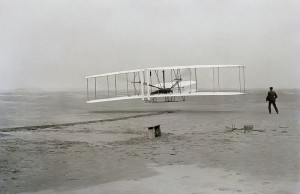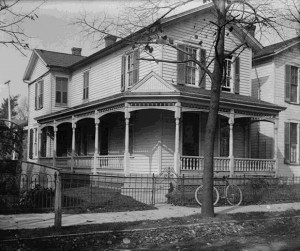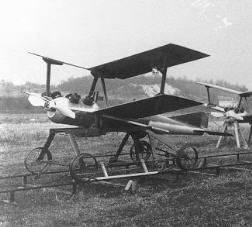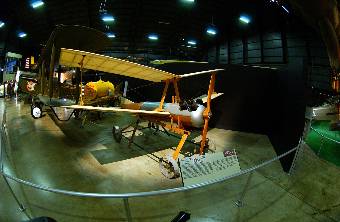It’s time for a My Town Monday post, and I wasn’t sure what I was going to blog about today until I saw the date.
It’s not a significant date to everyone, but if you’ve ever flown in an airplane, it’s significant to you, because December 17, 1903 was when Wilbur and Orville Wright made their historic, first flight.
“But Jennette, why are you blogging about something that happened in North Carolina? You’re from Dayton, Ohio!” you might ask.

The historic first flight at Kill Devil Hills, NC
Yes, I am from Dayton, Ohio–and so were the Wrights! That historic first flight might have happened elsewhere, but ninety percent of the work that led up to it (and followed) happened in Dayton.
In 2003, when the city was awash in celebrations and special commemorative events, The Dayton Daily News conducted a survey. I don’t have access to it now, and don’t know how large or scientific the sampling was, but the results were surprising regardless. While most people did indeed know that Wilbur and Orville Wright invented the first powered aircraft, less than half of the respondents knew the airplane was invented in Dayton, or that there was any connection with Dayton at all. A surprising number didn’t even know where the first flight took place, and many thought all the work had been done in North Carolina.

Where it all began – the Wright home at 7 Hawthorn Street, Dayton, Ohio
Home in Dayton is where the Wrights studied birds in flight for countless hours. It’s where their bicycle shop was, where they studied the workings of gears and chains, much of which later found its way into their early designs–for example, they used bicycle chains to connect the two propellers to the engine. Home in Dayton is where the Wrights flew kites to study how wind interacted with cloth-covered panels (and where many people thought they were crazy, or at least weird). It was where they built a wind tunnel, and experimented with miniature aircraft and propellers to determine the most flight-worthy designs. It was where they hired mechanic Charlie Taylor to develop the most powerful engine possible with the technology of the day, in the lightest weight. It was where their sister, Katharine Wright, sewed yards upon yards of white sateen fabric for the Wright Flyer’s wings.
They started traveling to the Outer Banks in 1900, when they began experimenting with gliders large enough to carry a person. They needed steady, straight-line winds to fly it–something not in good supply in Ohio. The area they chose was remote, difficult to access, and the weather was often miserable. On December 14th, a week before they’d planned to leave for the winter, they flipped a coin. Wilbur won the toss.
The plane got off the ground, but immediately crashed. Wilbur was unhurt, but the aircraft wasn’t, so they spent the next three days repairing it.
On the 17th, the winds were a bit on the strong side, but they both decided if they didn’t fly then, they probably wouldn’t that year, so Orville took his turn manning the craft. He flew, for a whole twelve seconds, and about 100 feet beyond the end of the launch rail. They made three other flights that day, the longest being 59 seconds and about 800 feet, before the craft again crashed and required extensive repairs. But this time when they packed it in, they’d accomplished what they’d worked toward for many years.
Just like publishing a book, that first flight wasn’t the end of the Wrights’ work, but the beginning. They researched and experimented over the winter. When they returned to Kill Devil Hills in the spring, it was to pack up their campsite there. They continued their work in Dayton from that point forward, with a craft that could fly in variable winds and make turns.
What about you? Did you know that Orville and Wilbur Wright did the vast bulk of their research and development work in Dayton, Ohio? Have you worked on something for years, only to realize the achievement wasn’t an end, but a beginning? I’d love to hear from you – please share!
Photos are public domain (copyright expired)
 Jennette Marie Powell writes stories about ordinary people in ordinary places, who do extraordinary things and learn that those ordinary places are anything but. In her Saturn Society novels, unwilling time travelers do what they must to make things right... and change more than they expect. You can find her books at Amazon, Barnes & Noble, Smashwords, Kobo, iTunes, and more.
Jennette Marie Powell writes stories about ordinary people in ordinary places, who do extraordinary things and learn that those ordinary places are anything but. In her Saturn Society novels, unwilling time travelers do what they must to make things right... and change more than they expect. You can find her books at Amazon, Barnes & Noble, Smashwords, Kobo, iTunes, and more.



